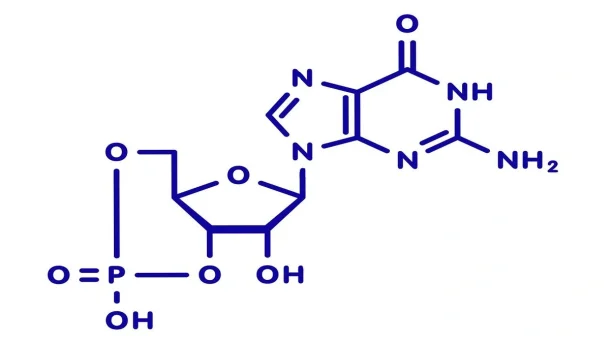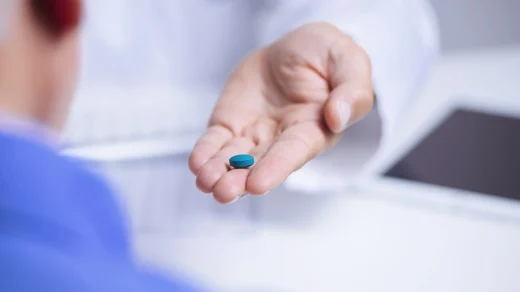Cyclic guanosine monophosphate (cGMP) is a round molecule made from another kind called GTP. It comes from something called guanosine triphosphate. Like cyclic AMP, cGMP works as a second messenger. The main way this works is that inside cells, protein kinases get turned on. This happens when peptide hormones join with the outside of these cells. By turning on protein kinase, cGMP can make smooth muscle less tense. Urinary cGMP levels can be measured according to kidney function and the diagnosis of diabetes.
What is the Synthesis of cGMP?
Guanylate cyclase (GC) is the one that makes cGMP. This enzyme changes GTP into cGMP. Hormones like atrial natriuretic factor, found in peptides, turn on GC that matches up to their cell’s surface. On the other hand, there is a soluble form of GC too. (sGC) is normally activated by nitric oxide to stimulate cGMP synthesis sGC ODQ (1H-[1,2,4]. can be used oxadiazole inhibited [4, 3-a]quinoxalin-1-one) application.
What function of Cyclic guanosine monophosphate?
CGMP often controls how ion channels work, helps break down glycogen, and causes cells to die. It also soothes smooth muscles. The smooth muscle in the blood vessels causes the vessels to dilate and the blood to rise. In the striatum, cGMP controls how well neurotransmitter release works.
Phototransduction in the eye is controlled by cGMP. In the animal eye’s light-detecting cells, the act of being exposed to light turns on a protein that breaks down cGMP. Sodium ion channels in photoreceptors are cGMP-gated, so low levels of cGMP shut down the sodium channels, causing hyperpolarization of the plasma membrane of the photoreceptor, which ultimately transmits visible information to the brain
cGMP seems to control the change of pyramidal cells’ attraction towards their top dendrites in layer V of the cortex. This is likely done through semaphorin-3A (Sema3a).7 Where Sema3a repels pyramidal cell axons, it is attracted by apical dendrites. The shrinking is caused by more SGC (soluble guanylate cyclase) in the top parts of the dendrites. SGC generates cGMP, resulting in a chemical reaction sequence that induces the sequestration of Sema3a. Lack of axonal SGC results in dissociation from Sema3a. This process ensures that pyramidal neuron cells are arranged in a certain way during the growing stage.
cGMP is produced, like cAMP, when odorants receive odors. cGMP is produced more slowly and persists longer than cAMP, suggesting that it affects long-term cellular responses to odor stimulation, such as long-term potentiation of both CGMP membrane guanylyl cyclase (GC) and soluble guanylyl cyclase (sGC). They are in smell community build. Studies have shown that cGMP is made in the smelling part of the brain due to sGC being activated by nitric oxide. This means how our brains smell things is related because they are linked together this way. CGMP needs more internal cAMP levels. This could be because of increased calcium inside cells where the second messengers appear connected.
Degradation
Some common enzymes can break down the cGMP compound into 5′-GMP. PDE 5, -6, and -9 are only good for breaking down cGMP. On the other hand, PDE1, -2,-3,-10 and peculiar kinds of drugs called enzymes can break both cAMP in addition to its partner molecule named spermine guanosin monophosphate acetic like thiamylal or G.
Phosphodiesterase blockers stop cGMP from breaking down. This makes its effects stronger and lasts longer. For example, drugs such as sildenafil (Viagra) increase the release of cGMP vasodilators in the corpus cavernosum by inhibiting PDE 5 (or PDE V) This is used as an erectile dysfunction drug sleep dysfunction. However, the drug can slow down PDE6 in our eye area (less than it does for PDE5). This suggests a loss of visual sensitivity but is unlikely to interfere with normal visual function, except in normal visual conditions when the object is already close to the cornea PDE5 inhibitors, e.g. tadalafil, largely avoid this effect.
| Names | Properties |
| IUPAC name:
|
Guanosine 3′,5′-(hydrogen phosphate) |
| Systematic IUPAC name:
|
2-Amino-9-[(4aR,6R,7R,7aS)-2,7-dihydroxy-
2-oxotetrahydro-2H,4H-2λ5-furo[3,2-d] [1,3,2]dioxaphosphol-6-yl]-3,9-dihydro-6H- purin-6-one |
| Other names:
|
cGMP; 3′,5′-Cyclic GMP; Guanosine cyclic
monophosphate; Cyclic 3′,5′-GMP; Guanosine 3′,5′-cyclic phosphate |
| Chemical formula | C10H12N5O7P |
| Molar mass | 345.208 g·mol−1 |
FAQs:
Q1. What happens when you increase cGMP?
Ans: However, treatments that induce significant increases in cGMP or overexpression of PDE2 in these cells counteract the cAMP-mediated decrease in permeability; The results suggest that high cGMP levels act by binding to an allosteric site on PDE2 to induce PDE2-mediated cAMP cleavage in these cells.
Q2. How do I activate cGMP?
Ans: One of the major mechanisms for mediating the effects of nitric oxide is the production of second messenger cyclic GMP (cGMP). Nitric oxide can stimulate cGMP synthesis by interacting with the enzyme soluble guanylate cyclase (sGC) heme group. This interaction allows sGC to convert GTP to cGMP.
Q3. What hormones increase cGMP?
Ans: The stimulation of cGMP by progesterone and androstenedione was more pronounced than that of estradiol.
Q4. Which bacteria increase cGMP?
Ans: Carl Bauer of Indiana University and his colleagues in this issue of Molecular Microbiology provide unambiguous evidence that the alpha protein bacterium Rhoda spiraled continuum produces cGMP and uses it to regulate the growth process through a cGMP-dependent transcription factor
Q5. Does Viagra decrease cGMP?
Ans: Sildenafil (Viagra), a specific PDE5 inhibitor, promotes erectile dysfunction by inhibiting PDE5 activity, leading to cGMP accumulation in the corpus cavernosum



